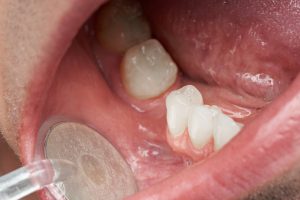
Plaque in our mouths
Our mouths are full of bacteria, which, in combination with mucus and other particles, form a sticky, colorless “plaque” that lines our teeth. If it is not brushed away with proper oral hygiene practices, this plaque can harden and form “tartar.” Tartar cannot be removed by simple bushing and contributes to the development of gum disease.
Risk factors for gum disease development include:
- Smoking: One of the most significant factors associated with the development of gum disease. Smoking has even been linked to lower chances of successful treatment.
- Hormonal changes: Specifically, the changes that occur in women make them more likely to develop gingivitis.
- Diabetes: This metabolic disease increases the risk of developing several diseases, including gum disease.
- Other illnesses and their treatments: For example, AIDS treatment can negatively affect the health of gums.
- Medications: Hundreds of prescription and over-the-counter medications can reduce saliva flow, increasing the chances of developing gum disease and other oral conditions.
- Genetic susceptibility: Some individuals are more susceptible to developing gum disease.
A new study found that periodontal disease was tied to a 14 percent higher risk of developing any type of cancer for post-menopausal women. More concerning is the fact that post-menopausal women who have never smoked are still at high risk.
High risk of cancer
Gum disease was associated with a higher risk of lung cancer, gall bladder cancer, melanoma, and breast cancer.
“These findings may provide a new target to test an intervention for cancer prevention—oral hygiene and periodontal disease treatment and prevention,” said lead researcher Jean Wactawski-Wende, the dean of the School of Public Health and Health Professions at the State University of New York at Buffalo.
The study looked at data from nearly 66,000 women aged 54 to 86 who took part in the Women’s Health Initiative Observational Study. Questionnaires given from 1999 to 2013 were utilized, which could be seen as a possible limitation of the study as it relied on self-reporting of gum disease.
Over an average follow-up of eight years, 7,200 cases of cancer were identified.
The study researchers and their colleagues agree that more investigation is needed to define the connection between gum disease and cancer, but they still implore people to be on the lookout for the telltale signs of gum disease. These may include bleeding gums when you brush your teeth and loose teeth.
Related: Gum disease bacteria may be tied to rheumatoid arthritis